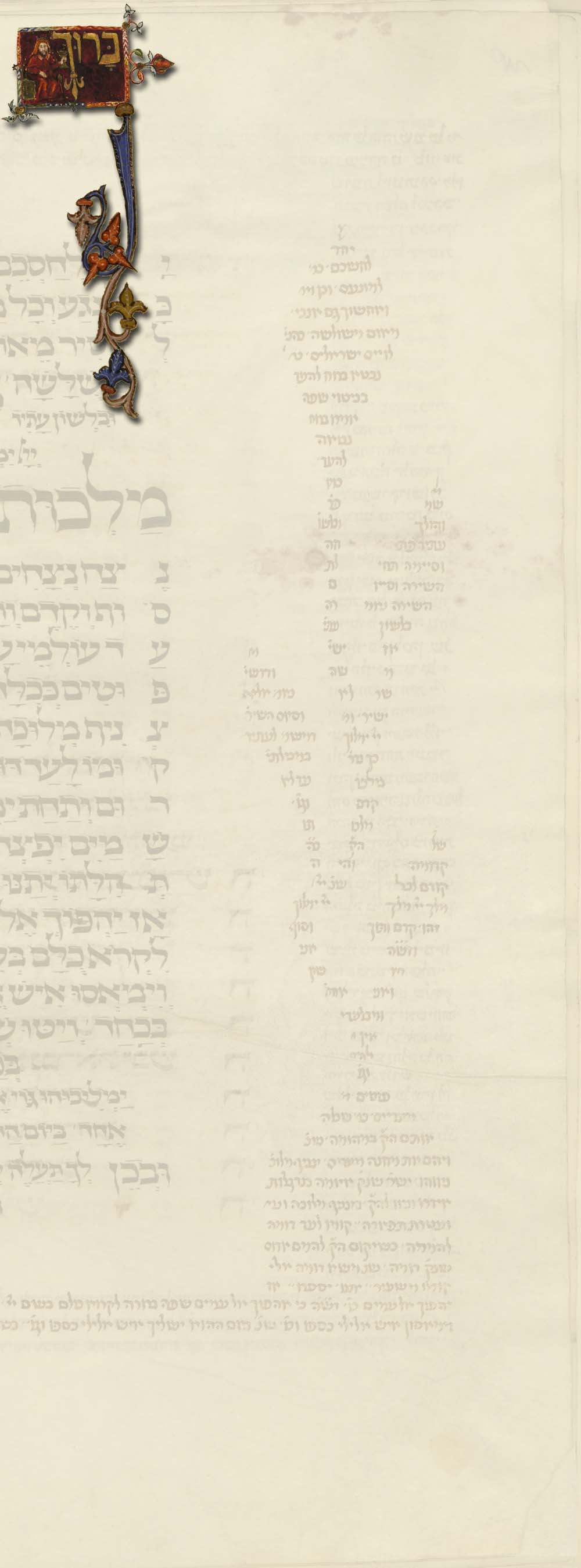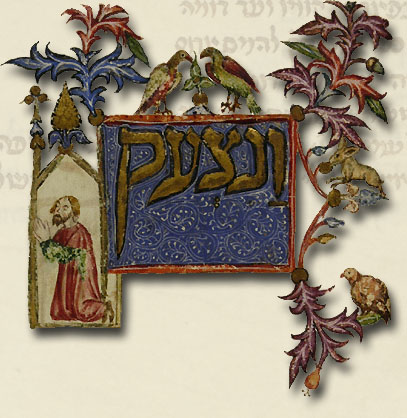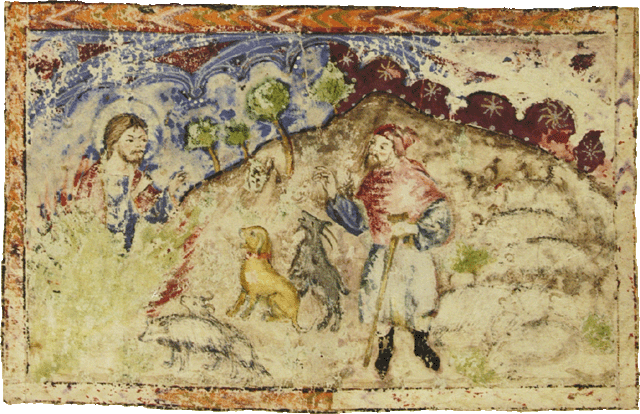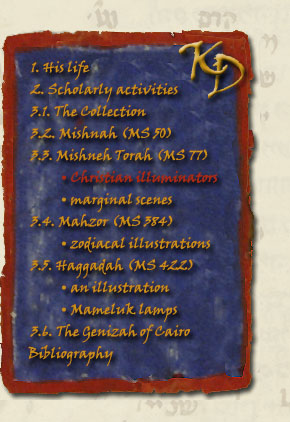



In this context it may be noted that Kaufmann already touched upon the question of an eventual participation of Christian artists in the production of Jewish manuscripts and he basically denied this possibility. 99 Narkiss shares his view: “Undoubtedly most of the illuminators of Hebrew manuscripts were Jewish”. 100 In connection with Ms. British Library Or. 2884 Munkácsi remarked that it is impossible to assume that the artist of the famous scene of the interior of a synagogue (see below) was not a Jew. 101 There can be found, however, several signs indicating that this precisely did happen in the illuminated manuscripts of the Kaufmann Collection. In addition to the examples quoted above we can adduce one scene in the Kaufmann Haggadah, where a nimbed young man emerges from the burning bush. Müller and von Schlosser had already recognized this as the representation of God in Christ's figure (fol. 59v). 102 Scheiber considered this view a mistake: in his view we are seeing God's angel here. 103 Although the Bible talks of God's angel appearing to Moses at the given place (Ex 3:2), two verses later it is God who addresses him out of the burning bush. It is a well-known fact that the Bible often does not differentiate between God and his angel, considering the latter as the form in which God appears to humans. At the same time it can also be evident that for the Christian exegete the angel carries the features of Christ because the Scripture says of him later on that the angel is the saviour from all evil and harm (Gen 48:16). 104 According to the Jewish legend Moses heard God's voice but it was Gabriel who appeared to him. 105 On account of all this it may have seemed quite plausible to a Christian illuminator to represent the angel as Christ. For the interpretation of the figure it would be essential to know whether it is winged, but this question cannot be decided unanimously because of the bad condition of the illustration. At the same time it may be noted that the youth is bearded, and angels are only rarely depicted in this way, while Christ in Christian art is regularly represented as a bearded young man. 106

Metzger adduced a nearly completely
identical representation in a 13th c. French Christian manuscript, the Psalter
of St. Louis, remarking that the figure depicted there is undoubtedly that of
Christ. He seems to shrink back from drawing the conclusions, however, declaring
in connection with the Kaufmann Haggadah in one
 place that of course it is out
of the question that it could be either God's or Christ's representation, while
in another place he seems to accept this interpretation. 107
And it was surely no mere chance that he presented the two illuminations one
after the other in the section of illustrations of his work. 108
place that of course it is out
of the question that it could be either God's or Christ's representation, while
in another place he seems to accept this interpretation. 107
And it was surely no mere chance that he presented the two illuminations one
after the other in the section of illustrations of his work. 108
As far as our manuscript is concerned, the most remarkable thing is that none of its subsequent owners seems to have taken offence at this representation! Unlike the Rylands Haggadah, where efforts have apparently been made to obliterate the figure of the angel from the flames emerging from the burning bush, 109 or the Dyson Perrins Haggadah, where a localised damage suggests that the face of the angel may have been erased from the flame. 110 In the Yahuda Haggadah there is a winged angel appearing above the burning bush. 111 In the Golden Haggadah, too, a winged and nimbed angel appears on the mountain above the burning bush, 112 and in the Haggadah bearing the shelf-mark Or. 1404 in the British Library the head of an angel (?) can be seen amidst the flames. 113 It is more proper for a Jewish illuminator to represent the Lord or His angel by rays of gold and the part of a wing, or by a hand stretching out of a wing as in the case of the Sarajevo Haggadah or in the Haggadah Or. 2737 of the British Library: there can be no doubt that the former illumination represents the angel; perhaps the latter one does too, yet could it not be supposed that in the latter the wing is representing the angel while the hand the presence of the Lord? 114 One could also refer to the Second Nürnberg Haggadah, where a banderole can merely be seen appearing slantwise from the sky – perhaps from a cloud? – with a brief description of the scene in Hebrew. 115
 It is at least doubtful whether we are
seeing God taking a rest at the end of the Creation in the Sarajevo Haggadah
(f.2r) as suggested by Müller's and
von Schlosser's caption (Gottes
Sabbathruhe): this manuscript represents the presence of God by rays of gold
(God addressing Adam in Paradise; f.3v), a hand reaching out of the sky (the
sacrifice of Isaac; f.8r), and by rays of gold and angelic wings together (the
burning bush; f.21v). It is more likely that the seated figure in the hood
represents a believer observing the Sabbath. 116
It is at least doubtful whether we are
seeing God taking a rest at the end of the Creation in the Sarajevo Haggadah
(f.2r) as suggested by Müller's and
von Schlosser's caption (Gottes
Sabbathruhe): this manuscript represents the presence of God by rays of gold
(God addressing Adam in Paradise; f.3v), a hand reaching out of the sky (the
sacrifice of Isaac; f.8r), and by rays of gold and angelic wings together (the
burning bush; f.21v). It is more likely that the seated figure in the hood
represents a believer observing the Sabbath. 116
 Scheiber
adduced further data to indicate the Christian
background of the Kaufmann
Scheiber
adduced further data to indicate the Christian
background of the Kaufmann
 Haggadah's illuminator: in the representation of the death of the first-born,
there are women among the pallbearers (f.1v), and people kneel during
prayer (f.26r) 117
– in this illustration one of the figures has his hat on while the other is
bareheaded during prayer. 118
Scheiber
also adduced the representation of the dead without a coffin in the illustration
of the death of the first-born as a sign of the Christian backdround of the
illuminator. This question requires further investigation. In the Middle Ages
there was no general rule as to whether the burial should be in a coffin or not.
In Spain the coffin was not in vogue. On the other hand, French Jews seem to
have used it – and French customs may have influenced nearby Catalonia. 119
Maimonides, who was born and grew
up in Spain, also mentions the use of wooden coffins. 120
Sed-Rajna regards this way of
representation as being in accordance with Jewish custom. 121
Haggadah's illuminator: in the representation of the death of the first-born,
there are women among the pallbearers (f.1v), and people kneel during
prayer (f.26r) 117
– in this illustration one of the figures has his hat on while the other is
bareheaded during prayer. 118
Scheiber
also adduced the representation of the dead without a coffin in the illustration
of the death of the first-born as a sign of the Christian backdround of the
illuminator. This question requires further investigation. In the Middle Ages
there was no general rule as to whether the burial should be in a coffin or not.
In Spain the coffin was not in vogue. On the other hand, French Jews seem to
have used it – and French customs may have influenced nearby Catalonia. 119
Maimonides, who was born and grew
up in Spain, also mentions the use of wooden coffins. 120
Sed-Rajna regards this way of
representation as being in accordance with Jewish custom. 121
We can state now that in view of the proofs adduced in our present article it seems reasonable to assume that in some places and periods at least Christian artists did participate in the illumination of Hebrew manuscripts. After all, illuminated manuscripts were expensive luxury articles which were produced in small numbers only because demand was not great and most of the time the market was probably too small for illuminators specializing in Hebrew manuscripts. However, it can be said that this problem requires further detailed research before a final general statement can be made because conditions may have changed considerably from place to place and from time to time. 122
An interesting parallel can be adduced here for a similar case when representatives of one religion follow their own traditions in the execution of illustrations in manuscripts belonging to the sphere of another religion: in a Persian manuscript from the sixteenth century preserved in Oxford, the Queen of Sheba is depicted as crossing a real river in front of Solomon. This, however, does not correspond to Islamic tradition but is in accordance with Christian beliefs. This strange phenomenon can be explained by the preponderance of Christians among Persian miniators in those times. 123
The proofs for an eventual Christian provenance of illustrations must be carefully weighed in every case: not everything is a proof what seems to be one at first sight. Such a case can now be demonstrated in an important though little-known Hebrew manuscript illuminated by a Christian artist in another Hungarian collection. The most beautiful Hebrew manuscript of the National Széchényi Library in Budapest contains the Sefer Mordechai, a compendious legal digest of the Talmud by Mordechai ben Hillel from the 13th century destined to replace that voluminous work in everyday life (Ms. Fol. Hebr. 1). The manuscript is dated 1372/3 and it was possible to show recently that it had emerged from a well-known workshop in Lower Austria. There can be no doubt that the illuminators of this manuscript were Christians, who produced Latin manuscripts in the first place but in some cases they worked for Jewish patrons also. It has been assumed that one of the proofs for the Christian background of one of the illuminators is the fact that some heads appearing in the marginal ornamentations are placed upside down. Obviously, it has been assumed, the illuminator was at a loss which way to hold the leaves and on certain occasions he made the wrong choice. 124 Upon closer investigation, however, it becomes clear that this is out of the question because the structure of the ornamentations leaves absolutely no doubt that the illuminator, even if he did not understand the Hebrew text, was perfectly aware of the right position of the leaves. Namely, the pen-and-ink drawings in question are connected to the left margin of the scribal columns because they emphasize words appearing at the beginning of chapters, i.e. standing on the left side of the columns. In fact, the illuminator never made any mistake in this respect; these strange heads can be attributed to his playful nature instead. This interpretation is further substantiated by the observation that in two cases two heads appear on the same leaf with one in normal position and the other placed upside down. In a third case one head is in the normal upright position while another is placed horizontally on the same leaf. In general, the proportion of these irregularly placed heads is also significative: eight are placed upside down and one horizontally out of a total of eighty-four (or eighty-five). After all, it was not all too difficult to find the right position of the leaves after all. Even if the illuminator did not know Hebrew, the general structure of the script must have been clear to an artist with an eye specially gifted and trained for pictorial representation. In addition, the right margins of the scribal columns are always straight, while the left ones irregular, a feature unlikely to have escaped his attention.
An interesting area of interaction between the activities of Jews and their Christian neighbours widely represented in illuminated Hebrew manuscripts is the practice of music. The musical instruments depicted in these manuscripts are important witnesses of the cultural history of the areas of their origin and their detailed examination in comparison with contemporary Christian manuscripts is likely to yield promising results. The Kaufmann Haggadah (MS Kaufmann A 422) and the Tripartite Mahzor (MS Kaufmann A 384) (on both of them see below) contain some remarkable illustrations in this respect. Important attempts have been made recently at their precise interpretation against the background of similar contemporary illustrations elsewhere. 125
Returning to our wonderful manuscript of the Mishneh Torah, we note that the connection between the illustration and the text may be represented in a remarkable way by the figures of David and Goliath, which shows the future king with his crown, while Goliath is “in full armour with chain-mail, golden helmet and greaves, holding an enormous sword in his right hand and a shield in his left”. 126 This splendid picture adorns the frontispiece of Book Seven, which deals with the rules of gleaning among other things. The illustration is thus an allusion to the gleaning of Ruth, the ancestress of David, while Orpah is Goliath's mother according to the Midrash (Ruth 1:4). 127
99
Kaufmann 1898. 295-311.
Id.: Bilderzyklen.
In: Id. 1908-1915. III. 260-261.
Cf. von Schlosser:
Bilderschmuck 1898. 229-230, 232.
100 Bezalel
Narkiss: Hebrew illuminated manuscripts in the British Isles.
A catalogue raisonné. I. The Spanish and Portuguese manuscripts.
Jerusalem – London 1982. I. 14.
101
Munkácsi c. 1938. 247.
102 David Heinrich
Müller – Julius
von Schlosser: Die
Bilderhaggaden der europäischen Sammlungen. In: David Heinrich
Müller – Julius
von Schlosser: Die Haggadah von Sarajevo. Eine
spanisch-jüdische Bilderhandschrift des Mittelalters. Vienna 1898.
198 [ad pag. 103]. von Schlosser: Bilderschmuck 1898. 232.
103
Scheiber 1957. 25.
104 Das zweite Buch Mose. Exodus
1961. 27. Das erste Buch Mose. Genesis. Übersetzt und erklärt von
Gerhard von Rad. 2. Auflage. [Das Alte Testament Deutsch. Neues
Göttinger Bibelwerk. Teilband 2/4.] Berlin 1967. 163-164 [ad
Gen 16,7: Der Engel des Herrn]. Bibel-Lexikon.
Hrsg. v. Herbert Haag. 4. Aufl. Leipzig 1981. 393-395 [s.v. Engel
Jahwes]. Claus Westermann:
Genesis. 2. Teilband. Genesis 12-36. 2. Auflage. [Biblischer
Kommentar. Altes Testament. Band I/2.] Neukirchen-Vluyn 1989. 289-291
[Exkurs: Der Bote Gottes].
105
Roth 1960. 147.
Sed-Rajna 1987. 93. For the representation of the angel cf.
Kaufmann: Bilderzyklen.
In: Kaufmann 1908-1915. III.
243-244 [No. 20].
106 Cf.
Metzger 1973.
285-286, esp. 2861, 2, 400 [ad p. 286, n. 2],
who does not exclude the possibility that the illustration may have been
subsequently painted over by Christians. Alexander
Scheiber also discovered
Christ's figure in the angel.
Scheiber 1957. 17. Réau 1955-1959. II. I. 34; II. II. 38.
107
Metzger 1973.
286-287, Pl. LXIV, fig. 367.
108 Ibid. Pl. LXIV-LXV, fig.
367-368.
109 Cf.
Narkiss: 1982. I. 88
[fol. 13v], II. 81 [Pl. LXXVI].
110
Metzger 1973. 280, Pl. LXV,
fig. 369.
111 Ibid. 281.
112
Narkiss: 1982. I. 62
[fol. 10v], II. 40 [fig. 132].
113 Ibid. I. 94 [fol. 1v],
II. 94 [fig. 283].
114 Eugen
Werber: The Sarajevo
Haggadah. Sarajevo 1988. fol. 21v.
Metzger 1973. 281-283.
David Heinrich Müller –
Julius von Schlosser: Die Haggadah des Bosn.-herceg.
Landesmuseums in Sarajevo. In: David Heinrich
Müller – Julius
von Schlosser: Die Haggadah von Sarajevo. Eine
spanisch-jüdische Bilderhandschrift des Mittelalters. Vienna 1898.
40 [fol. 21'].
Narkiss: 1982. I. 47 [fol. 67r], II. 33
[Plate XXVIII, fig. 88].
115
Narkiss – Sed-Rajna 1981.
Card No. 60 [ad fol. 13r]. Cf.
Metzger 1973. 280-281, 286.
Müller –
von Schlosser: Die
Bilderhaggaden 1898. 143 [ad fol. 13r].
On the whole subject – with Christian parallels – see
Metzger 1973. 279-288
[Le buisson ardent].
Sed-Rajna 1987. 93-94. Cf.
also Réau 1955-1959. II. I.
185-186.
116
Müller – von Schlosser: Die
Haggadah von Sarajevo. Eine spanisch-jüdische Bilderhandschrift des
Mittelalters. Vienna 1898. Tafelband. fols 2, 3', 8, 21'.
Werber 1988. 24, 27
(essay).
117
Scheiber 1957. 16-17. Ibid.
27 [ad p. 40].
118 Ibid. 27 [ad p.
40].
119 In the Middle Ages, the
Provence was culturally and linguistically nearer to Spain than to
France. Roth
1960. 142.
120 Encyclopaedia Judaica.
Jerusalem – New York 1971-1972. IV. 1519 [s.v. Burial], V. 657-658 [s.v.
Coffin].
121 Gabrielle
Sed-Rajna: The Kaufmann
Haggadah. Budapest 1990. 19.
122 On this subject cf., e.g.,
Evelyn Cohen’s contribution
The Kaufmann Mishneh Torah illuminations in the present volume
and Suckale 1988. 123-134.
— On an important aspect of the possible early interaction between
Christian and Jewish art, see
Sed-Rajna 1987. 155-156. Gabrielle
Sed-Rajna: Les
synagogues antiques. Architecture, peintures murales, mosaïques du IIIe
au Xe siècle. In: Gabrielle
Sed-Rajna – Ziva
Amishai-Maisels – Dominique
Jarrassé – Rudolf
Klein – Ronny
Reich: L'art juif. Paris 1995. 126-127.
123 André Chastel: La rencontre de Salomon et de la Reine de Saba
dans l'iconographie médiévale. In: Gazette des Beaux-Arts 35 (1949)
105, 106 [fig. 5].
124 See
Samuel Kohn: Die
hebräischen Handschriften des ungarischen Nationalmuseums zu Budapest.
Sonderabdruck aus dem Magazin für die Wissenschaft des Judenthums von
Dr. Berliner und Dr. Hoffmann. Jahrg. 1877. Berlin 1877.
Id.: Mardochai ben
Hillel. Sein Leben und seine Schriften sowie die von ihm angeführten
Autoritäten. Nebst 6 bisher unedirten hebräischen Beilagen unter
Benutzung handschriftlicher Quellen. Breslau 1878. [Separatabdruck
von Frankel-Graetz’s Monatsschrift für Geschichte und Wissenschaft des
Judenthums. [[Bd. 26-27]]. Jahrgang 1877 und 1878.] Andreas
Fingernagel – Alois
Haidinger: Neue Zeugen
des Niederösterreichischen Randleistenstils in hebräischen, deutschen
und lateinischen Handschriften. In: Codices Manuscripti 39/40 (2002)
15-35 [Andreas Fingernagel: Die hebräischen Handschriften in Budapest
(Cod. Hebr. 1) und Wien (Cod. Hebr. 77)], esp. 33.
125 See now András
Borgó: Középkori héber
kéziratok zenei vonatkozású illusztrációi. [=Illuminations relating to
music in medieval Hebrew manuscripts]. In: Magyar zene [=Hungarian
Music] 4 (2001) 395-416.
126
Sed-Rajna 1984. 30-31.
127
Narkiss – Sed-Rajna 1988.
First Kaufmann Mishneh Torah. Card No. 15.
